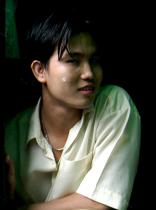Yangon fish market, by Paola Casali
On Camera Obscura pages, as in many interventions about photography spread around both the virtual and the real world, I insist on the fact that pictures don’t necessary have a mimetic relationship with reality. Being an icon is one of the possible characteristics of photography, but absolutely not the most fundamental and constitutive.
Although this, photography is often iconic, and that was the characteristic that initially attracted me, the first time that I took a camera in my hands to impress what surrounded me, without saying anything about symbols, icons and index. Despite all I learnt after that, the narrative possibilities of photography still live in me: showing an angle of a distant world, people, things, lost paradises. Therefore reportage, even though Camera Obscura mostly talks about fine art photography, is one of my biggest passion ever.
Some years ago, while Paola Casali was showing some shots of her last travels, I saw a picture that suddenly brake my heart, taken at the Yangon fish market.
Apart from the love I feel towards distant travel, places and people’s pictures that I just talked about, this image always shocked me for its structure and visual content.
Generally I’m not so comfortable with the squared format. Even if many photographers love it, I feel like I’m missing some space or I have too much and I’d like to cut it away. I’m not surprised by the praise of the square by Michele Vacchiano:
As the streets of Turin or Trieste [the square] frightens people, in its geometrical predictability skims the territories of the insanity. It is a paradox, it terrifies. Inside the square there’s no direction, there’s no base or height, as each side is able to take both roles. In its formal ambiguity every kind of orientation gets lost, every kind of mental docking disappears. In the center of Turin (squared, regular, alien city for those who are not born into it) Nietzsche the philosopher got crazy.
Michele Vacchiano
For the same reason there are only few pictures that I love in this format and this is an amazing example. In this case the square is perfectly filled up and managed; the elements, even if heterogeneous and antithetic, seem to be assembled in a cyclic mode, as in the famous picture of Esher Ascending descending.
This is the characteristic that I mostly admire in this picture. It is an image that contains two completely different ones. It is an alive, dynamic, noisy and moved image of a man that is washing himself naked in the exact moment when he throws some water on himself from the basin. The other one is static, silent, and staid; the boy staring out the window with his flawless shirt, his arm leaning on the window sill. One with his eye opened and the other one is looking at the camera. One submerged by the blinding white light of the street, the other one has the black background of the house. One has a half grimace painted on his face, the other one something like a smile. The two elements of the picture are so heterogeneous, and beautiful, they could be two completely different and independent pictures. Those two elements are so into each other that they create a unique, equilibrated image.
Summing up, I’m reporting the words that Paola Casali would like her picture about the Yangon fish market would be accompanied by:
I came back from that trip and I started feeling ashamed for my way of life. There are places all around the world where people live with some rice per day, places where one rat can be a rich meal. We are free; over there, they do not now what freedom is. This is very sad.
Paola Casali







